
Hands on Review: Ss Brewtech Brew Bucket Fermenter!
This review is by Homebrew Finds Contributor Brad Probert. Brad is an engineer, expert homebrewer and experienced reviewer. Grab a link to Brad’s website at the end of this review.
Updated: 5/3/2024
Ss Brewtech Brew Bucket
Right from the start I knew there was something special with the Ss Brewtech fermenter as I opened the box it came in. Having received some gear that came out of torn and collapsing boxes recently, it stood out to me how the box was completely together. While you might chalk that up to how careful the delivery guy was, I could tell this box was designed with purpose. The thickness of the layers, and the construction of the layers were clearly designed to handle both scrapes and crushing loads. All this might seem trivial, until you unbox that new shiny piece of equipment you’ve spent your hard-earned dollars on and find it scratched, scuffed, or slightly out of round. With the thought and purpose Ss Brewtech put into their packaging, you can tell that they wouldn’t accept those careless things to happen to their equipment. And that counts.
Compare Price, Models & Availability, Review Continues Below:
- Ss BrewTech at MoreBeer – additional Brew Bucket Sizes, Configurations and Accessories
- Ss BrewTech Fermenters at Keg Outlet
- Ss BrewTech Fermenters at Great Fermentations
- Search Amazon for “ss brewtech brew bucket” – offerings vary
This article contains affiliate links. We may make a small percentage if you use our links to make a purchase. You won’t pay more and you’ll be supporting Homebrew Finds and more content like this. Thank you for your support!
The Bucket
I evaluated the 7.5 Gallon Brew Bucket, together with the FTSs cooling system. The name Brew Bucket gives away its basic purpose, but there are a lot of additional details. It’s a cousin to the plastic fermentation bucket most of us had in our starter homebrew kits, just a lot more advanced. The obvious difference is that it’s made from stainless steel. Unlike that HDPE plastic bucket, it’s oxygen impermeable, scratch resistant, and not susceptible to holding hidden remnants of previous brew days to discolor it or hold aromas of hops past. It’s got a conical shape that helps collect yeast and hop trub when they precipitate out and drift to the bottom of your beer. And that cone shape is intended to minimize the surface area facing your beer, as most people find the flavor of spent yeast to be unappetizing. It’s got a good lid up top with a nice hinge system to lock and seal it, and handles at the side that fold down to allow it to tuck into tight spots. The final feature that stands out over the plastic brew bucket is the sampling spigot, to be used for gravity samples or transferring beer into your keg. And even better yet, it has a rotating rack arm that you can use to orient your sample to come from the center of your beer and not at the bottom in the midst of your deposited trub.
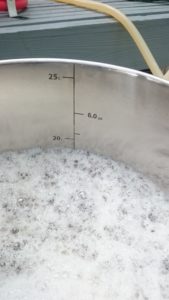 Etched volume markings on the inside of the Brew Bucket
Etched volume markings on the inside of the Brew Bucket
The FTSs
The FTSs is Brewtech’s fermentation temperature control system for when you need to lower fermentation temperature below the temperature of the room it’s in. They also have an FTSs2 option that adds a heat pad and a dual heating/cooling controller if you need to heat it up, but that wasn’t what I evaluated. The chilling is accomplished by a run of stainless coils that mount to the underside of the lid and circulate cold water from your user-supplied cold water source (cooler with ice water) with a provided submersible pump. Temperature is monitored by a temperature sensor that slides down inside a stainless thermowell which also mounts to the underside of the lid. In the 7.5 gallon fermenter, these extend far enough down to manage a 4.5 – 5 gallon batch of beer, or with optional extensions sold separately, can go as low as 2.5 – 3 gallon batches. The set temperature is easily entered with a simple digital controller, which displays the measured temperature and decides to turn on the pump (in your cooler of ice water) if the temperature goes 1 degree above your set point, and then shuts it off when it gets 1 degree cooler. To hold the temperature in and minimize effects from the room air temperature, it also comes with a form-fitting neoprene jacket (with hole to still access the sampling port).
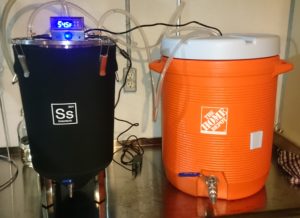 Brew Bucket with FTSs Hooked Up To Cooler
Brew Bucket with FTSs Hooked Up To Cooler
Hands on Review
To test this set-up out, I made a Scottish Ale that needed to be fermented at 55F in my 67F basement. Everything went together very easily with simple o-ring seals on the joints. The inside of the fermenter was beautiful- shiny and completely seamless. The build quality was simply amazing. The same attention to detail that went into the box it shipped in went into the design and quality control of the fermenter. Good sturdy gauge stainless was used throughout, and every edge on it was rolled to eliminate any hint of something sharp or an unfinished appearance. With just over 6 gallons of wort at 73F, I hooked up the cooling system and it cooled it down to the 55 degree temperature mark in about 2.5 hours so I could pitch my yeast. I managed the supply of cooling water by putting 3.5 gallons of water in a 10-gallon Igloo water cooler with the pump and adding 5 empty 2-liter bottles of frozen water/ice. This required tending to, by changing out the frozen 2L bottles every ~36 hours, but had no trouble holding the 55F temperature I had set within +/- 1 degree. The unit came apart easily for clean-up, and the stainless performed its role well of being easy to clean. With the smooth, seamless walls on the inside, it was easy to be confident in its cleanliness, too.
Summary
Overall, the Ss Brewtech Brew Bucket was impressive, to be sure. The level of build quality and design detail sets a new standard for me on high-end brewing equipment. The sampling spigot made sample collection for gravity checks easy, which surprised me at how geeked up I got over this. The cleanup was simple and fast and the durability of the stainless steel clearly showed this is a tool that will provide great service for years to come. The FTSs performed admirably and did everything I asked it to. I loved how well the cooling manifold and thermowell integrated into the system. It was a top-end product with lots of handy little features.
Compare Price, Models & Availability:
- Ss BrewTech at MoreBeer – additional Brew Bucket Sizes, Configurations and Accessories
- Ss BrewTech Fermenters at Keg Outlet
- Ss BrewTech Fermenters at Great Fermentations
- Search Amazon for “ss brewtech brew bucket” – offerings vary
More Photos
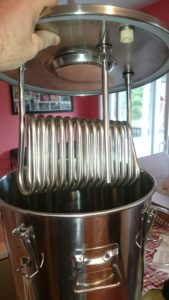 FTSs Cooling Coil and Thermowell Installed
FTSs Cooling Coil and Thermowell Installed
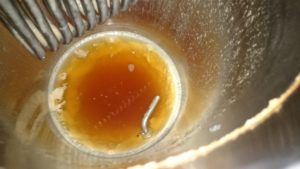 Rotating Racking Arm for Sample Spigot
Rotating Racking Arm for Sample Spigot
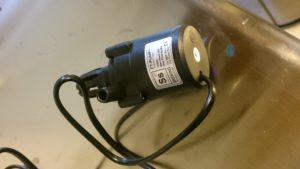 Submersible Pump for Cooling Water
Submersible Pump for Cooling Water
More Fermenter Reviews!
More Homebrew Finds!
- Last 50 Finds!
- Top Deals – a curated list of the best deals
- Homebrew Reviews – one of the largest libraries of homebrew reviews in existence!
- Our Top Posts – tips, how-tos, resources posts and more
- Let’s be Friends!
Recent Deals!
10 Most Recent Homebrew Resource Posts & How-To’s!
We are Homebrew Review HQ! Our 10 Most Recent Reviews
More Fermentation Related!
pinned
This post may contain affiliate links. We may make a commission when you use our links. This will never cost you extra. Thank you for supporting Homebrew Finds!
greatdealsBy Brad Probert. Check out Brad’s website – beersnobby.com
Special Thanks to Ss Brewtech for providing the unit used for evaluation in this review.
Price, promotions and availability can change quickly. Check the product page for current price, description and availability.
Make sure the components you use are compatible and rated for your intended application. Contact manufacturer with questions about suitability or a specific application. Always read and follow manufacturer directions. tag:lnksfxd review:ssbrewbucket rs:7 tag:tpr
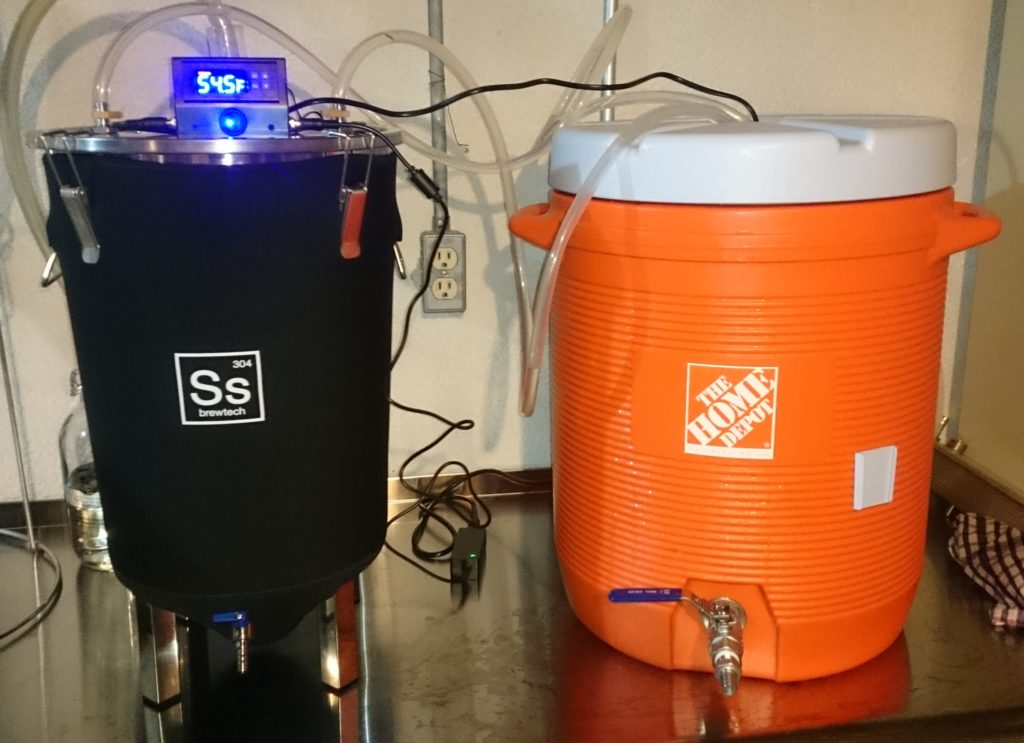
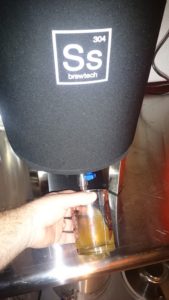
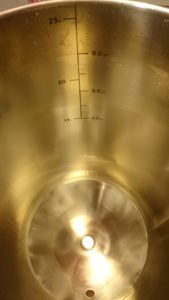
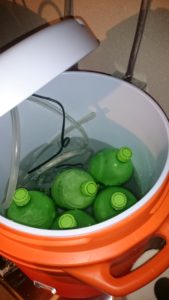





I have the original brew bucket – maybe 7 years now and have used it extensively. Some issues with the original have changed for the better but some issues remain. The poorly designed rubber feet are now much thicker and the lid gasket is much thicker and ribbed as are the thickness of the o-rings for each of the ports. All of these seems have leaked for me unless I use keg lube and increase tightening with a pair of slip lock pliers – about an extra half turn. The lid seal is particularly prone to leaking especially with wear although this could be due to some bending of the lid over time – things due fall once in a while. The temp control works well and the surface of the steel is excellent although periodic pacification with Tri-phophate is recommended. Lastly, the handles are still terrible and really need rubber padding. I added some rubber hose cut to length and then along the length to slip them on – not perfect but a huge improvement to the pain of carrying a full fermenter without them. All together a good and now improved product but one in which still more improvements could be made.
Now, I just purchased an additional steel fermenter and went with a Spike. This is a much more robust and better designed product although it is much younger and benefits from a great deal of hind-sight comparing competitors products. Tri-clove clamps and an improved lid seal with a clear lid port make all the difference although the wider profile is more difficult to load into a fermentation chamber.
Both of these fermenters also work very well with a blue-tooth enabled remote sensing Tilt hydrometer/thermometer although the range is diminished somewhat by the steel. Still works very well though. RC Bird, Professor Brewing Science
I have had some problems with leakage from the sampling port. You have to be careful to rotate the racking arm clockwise only. Turning it back will only loosen it and it will not retighten no matter how much you turn it clockwise again. Also there is a limit to how far you can turn it clockwise as it tightens, so you basically get one shot at turning that arm. Finally, putting the racking arm in the up position leaves a lot of beer at the bottom, so you have to really tilt the bucket (with the top off so you can see) when racking to make sure you get all the beer out and not the trub. Overall, it’s pretty poorly designed and engineered.
Thanks for the review. Did you notice any leaking from the sampling port? I believe that I read some people experienced some leakage due to the rotating racking arm…
Hey Jeff! I haven’t had that problem with my 3.5 gallon BrewBucket. I have a larger one, but haven’t used it yet. I’ll ask Brad to weigh in.
I had no leakage. I took several samples during fermentation (probably about 4), and rotated the rack arm 360-degrees each time. I didn’t want the dip tube pointing up as yeast was particulating out, and didn’t want it sitting in yeast trub when I took the sample.
I made sure to follow the suggestion of rotating only clockwise so as not to loosen the screw holding things together. It would also appear I assembled it wrong and put the o-ring on the inside of the bucket. I was going to change that next time around, not sure if that helped prevent leakage or not. Seems doubtful that an incorrectly assembled valve would be more leak-proof, though.
Thanks for the review. I’m sitting on go waiting to pull the trigger on one of these after months of debate. The biggest issue I’m coming to terms with is a single fermentation in this unit after have always done two stage. Can you comment on whether or not you did a single fermentation with this, and if so, your thoughts on it, length of time, clarity of the beer?
Thanks.
I did a Scottish Ale, fermented mostly at 55F for 2 weeks. I did do a secondary, but it was something unique/different for me. I typically transfer to a secondary for cold crashing before going to keg. But I’ve had some concerns about oxidation. So I transferred from the Brew Bucket into a Fermentasaurus that I could purge with CO2 like a keg through it’s pressurized top. The downside of the Fermentasaurus is that it’s huge and doesn’t fit in my fridge to cold crash unless I remove several shelves. But as I added some oak spirals to it, it worked out well to do this secondary with the oak and taste it every couple of days until I got the flavor I was after (only about 3 days). i then transferred to keg and skipped the cold crash.
As for clarity of the beer, it was not clear, but it’s not like it has any notable matter floating in it, so it just kind of makes it “glow” in my opinion.
If I wasn’t doing this secondary process with the oak, I probably could’ve put the brew bucket directly into the fridge for cold crash after fermentation, and made use of the racking arm to draw beer off above any precipitate.